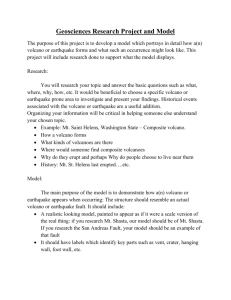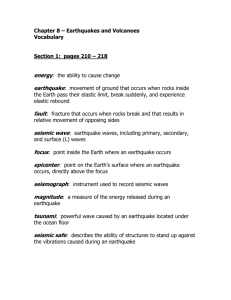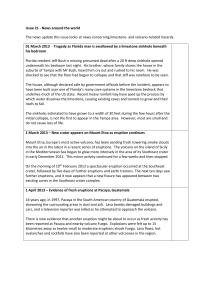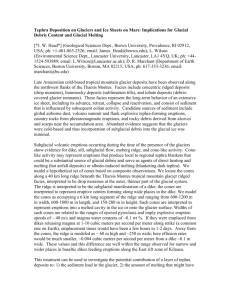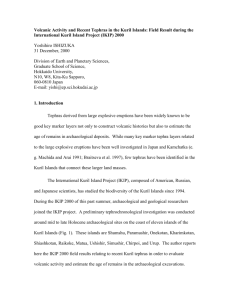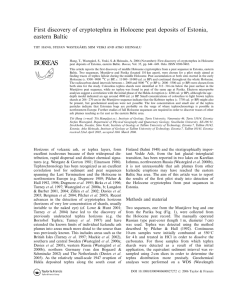doc
advertisement
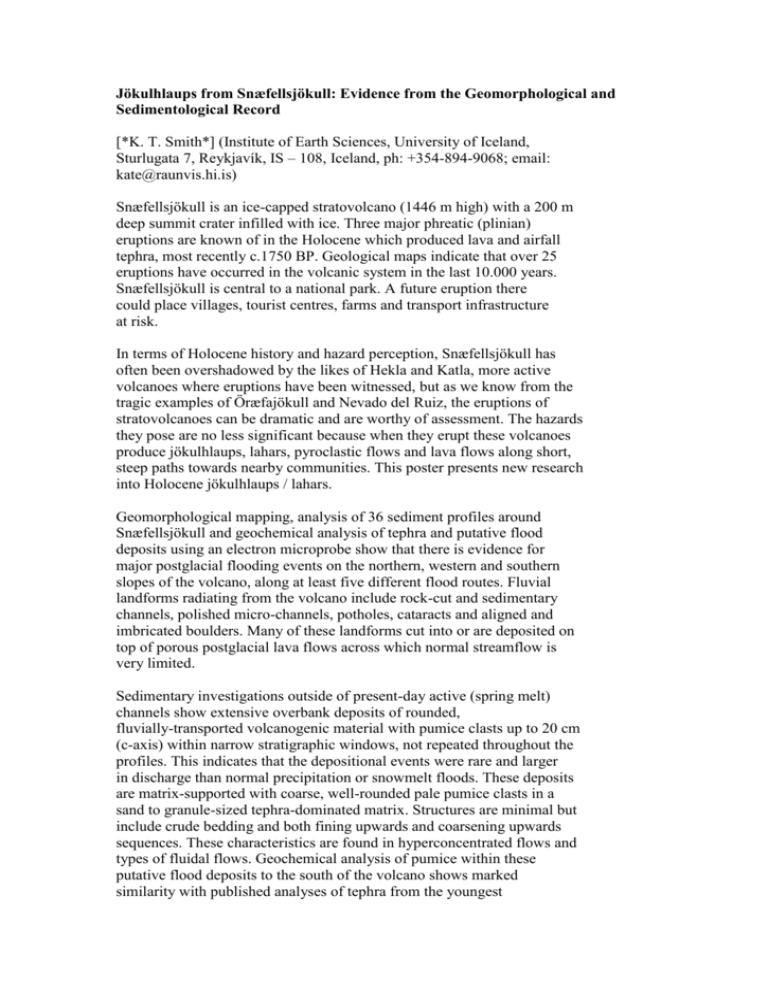
Jökulhlaups from Snæfellsjökull: Evidence from the Geomorphological and Sedimentological Record [*K. T. Smith*] (Institute of Earth Sciences, University of Iceland, Sturlugata 7, Reykjavík, IS – 108, Iceland, ph: +354-894-9068; email: kate@raunvis.hi.is) Snæfellsjökull is an ice-capped stratovolcano (1446 m high) with a 200 m deep summit crater infilled with ice. Three major phreatic (plinian) eruptions are known of in the Holocene which produced lava and airfall tephra, most recently c.1750 BP. Geological maps indicate that over 25 eruptions have occurred in the volcanic system in the last 10.000 years. Snæfellsjökull is central to a national park. A future eruption there could place villages, tourist centres, farms and transport infrastructure at risk. In terms of Holocene history and hazard perception, Snæfellsjökull has often been overshadowed by the likes of Hekla and Katla, more active volcanoes where eruptions have been witnessed, but as we know from the tragic examples of Öræfajökull and Nevado del Ruiz, the eruptions of stratovolcanoes can be dramatic and are worthy of assessment. The hazards they pose are no less significant because when they erupt these volcanoes produce jökulhlaups, lahars, pyroclastic flows and lava flows along short, steep paths towards nearby communities. This poster presents new research into Holocene jökulhlaups / lahars. Geomorphological mapping, analysis of 36 sediment profiles around Snæfellsjökull and geochemical analysis of tephra and putative flood deposits using an electron microprobe show that there is evidence for major postglacial flooding events on the northern, western and southern slopes of the volcano, along at least five different flood routes. Fluvial landforms radiating from the volcano include rock-cut and sedimentary channels, polished micro-channels, potholes, cataracts and aligned and imbricated boulders. Many of these landforms cut into or are deposited on top of porous postglacial lava flows across which normal streamflow is very limited. Sedimentary investigations outside of present-day active (spring melt) channels show extensive overbank deposits of rounded, fluvially-transported volcanogenic material with pumice clasts up to 20 cm (c-axis) within narrow stratigraphic windows, not repeated throughout the profiles. This indicates that the depositional events were rare and larger in discharge than normal precipitation or snowmelt floods. These deposits are matrix-supported with coarse, well-rounded pale pumice clasts in a sand to granule-sized tephra-dominated matrix. Structures are minimal but include crude bedding and both fining upwards and coarsening upwards sequences. These characteristics are found in hyperconcentrated flows and types of fluidal flows. Geochemical analysis of pumice within these putative flood deposits to the south of the volcano shows marked similarity with published analyses of tephra from the youngest Snæfellsjökull central volcano eruption. This data all placed together points towards Holocene jökulhlaup activity at Snæfellsjökull in channels radiating from the volcano. No sign has been found to date of extremely extensive flooding over whole flanks of the volcano. These overbank but spatially limited deposits are more similar to lahar and jökulhlaup deposits found in confined valley systems rather than the well studied sandur deposits associated with the largest historical jökulhlaup events in Iceland. This reflects the limited source of water from the smaller ice cap of Snæfellsjökull compared to Mýrdalsjökull and Vatnajökull and also topography which constrains flows to narrow zones rather than allowing spreading over large expanses immediately they leave the glacier margin. This poster presents new evidence of postglacial floods of volcanogenic material, most likely associated with eruptions within the Snæfellsjökull volcanic system, particularly the youngest eruption of the Snæfellsjökull central volcano c.1750 BP. This is important for assessing future hazards here and lessons learned about the nature of palaeojökulhlaup evidence at Snæfellsjökull can be applied elsewhere in the world. Importantly these results highlight the variability of evidence left behind by jökulhlaups in the geological record resulting from differences in volcano morphology and nature, extent of ice cover and topographic conditions. POSTER CORRESPONDING AUTHOR: K.T. SMITH




